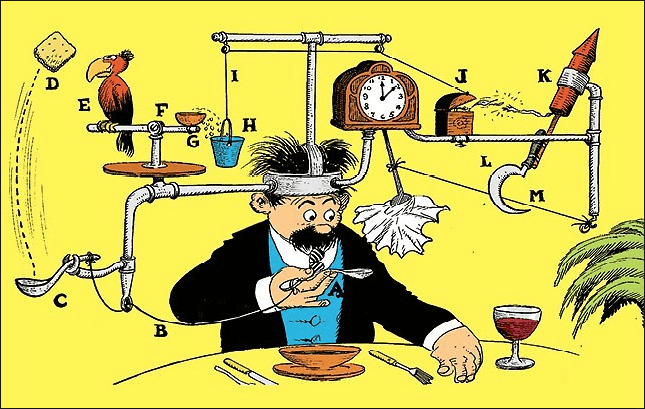Most of our time at Less Doing is spent coaching business owners on how to make their workflows & processes more structured, organized & efficient.
It’s a bit of a shock sometimes then, when I tell coaching clients one of our central tenets: “If your business process doesn’t sometimes look like a duct-taped structure falling apart at the seams, you’re doing it wrong”
A common thought exercise I do is ask people, if you had the choice between having a Rube Goldberg machine run your organization or a giant box with an on-off switch, which one would you pick?
The vast majority of people pick the latter, and it’s absolutely wrong.
One of the biggest things we learned when we were just starting out is that the best way to build a scalable, automated business organization is to break it up into pieces. An early mistake we made was investing thousands of dollars into an “all-in-one CRM” — it ended up being completely useless to us and continues to sit there gathering dust.
A smart, automated business has multiple moving parts which specialize in different business functions in your organization. Not only does this allow you to handle each business unit well, it also makes debugging easier — you have multiple points of failure that you can dive into rather than a single, massive, messy monolith.
For example, one of the companies we work with, ContentFly, has 73 different zaps running their entire platform AND company. 73! They have more zaps than they have lines of code.
People underestimate the sheer amount of powerful tools that are available, all flawlessly efficient.
Slack and Zapier is where it all begins — Slack should be the command centre of your operation, with Zapier being the pipes that bring all the other services in, allowing you to manage/monitor it from one place.
After that, it’s entirely up to you. Airtable is our weapon of choice, and Typeform is a great way of creating front-end or lead-in interfaces. Stripe & PayPal can handle your payments, while MailChimp and Intercom can automate customer marketing & communication.
If you aren’t using all of these touchpoints, in favor of just one catch-all system, you’re missing out on so much value. Each of these tools does their own specialization in a way that no catch-all will ever accomplish.
All told, we haven’t even brought up the best part of this: synergy.
By enabling multiple touchpoints, you can actually enhance the capabilities of each individual one. Zapier, for instance, has several Built-in Apps that let you format, filter & transform data before moving them from service to service.
You can literally automate everything.
Why give up that incredible power just to get hamstrung to a single tool? It’s an age-old mindset and a lazy one — if you aren’t aggressively fine tuning your processes and building a machine that can scale, you’re planning your own obsolescence.
Go build your Frankenstein.
But make sure it integrates with Zapier.




